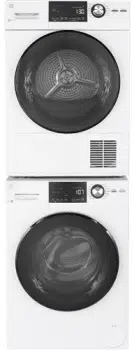Documents: Go to download!
User Manual
- Owner's manual - (English, French, Spanish)
- Energy Guide - (English)
- Specification Guide - (English)
- Specification Guide - (English)
- Owners Manual and Installation Instructions - (English)
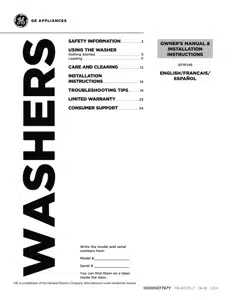
- USING THE WASHER
- CARE AND CLEANING
- TROUBLESHOOTING TIPS
Table of contents
USER MANUAL WASHERS
USING THE WASHER
Getting started
Throughout this manual, features and appearance may vary from your model.
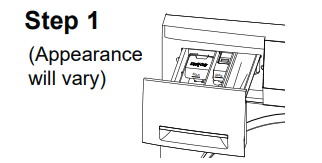 | • Add fabric softener to the fabric softener dispenser; see page 10. • Add the manufacturer’s recommended amount of detergent. GE Appliances recommends the use of High Efficiency detergents such as |
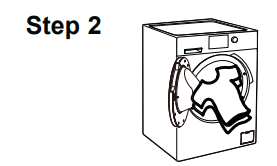 | • Loosely add items. Overloading may negatively impact wash performance. See page 11 for suggested loading examples. • Close door. NOTE: Washer will not start with door open. |
 | • If the screen is dark, press the Power button to “wake up” the display. • Select a wash cycle. (Defaults are set for each wash cycle. These default settings can be changed. See Control settings for more information.) |
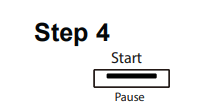 | • Press the Start/Pause button. |
Display and Status Lights
The display shows cycle status (FILL  WASH
WASH  RINSE
RINSE  SPIN), the Estimated Time Remaining until the end of the cycle and the options selected. In addition, the display will show:
SPIN), the Estimated Time Remaining until the end of the cycle and the options selected. In addition, the display will show:

NOTE: If an out-of-balance condition is detected by the washer, the SPIN light will blink during the remaining portion of the cycle and will stay illuminated for a short time after cycle completion. When this occurs, the washer is taking actions to correct the out-of-balance condition and complete the cycle normally. In some cases, the washer may not be able to balance the load and spin up to full speed. If you notice the load is more wet than usual at the end of the cycle, redistribute the load evenly in the wash tub and run a drain and spin cycle. Select Rinse+Spin cycle and select no rinse by pressing Rinse until both Extra and Normal lights turn off.
Controls
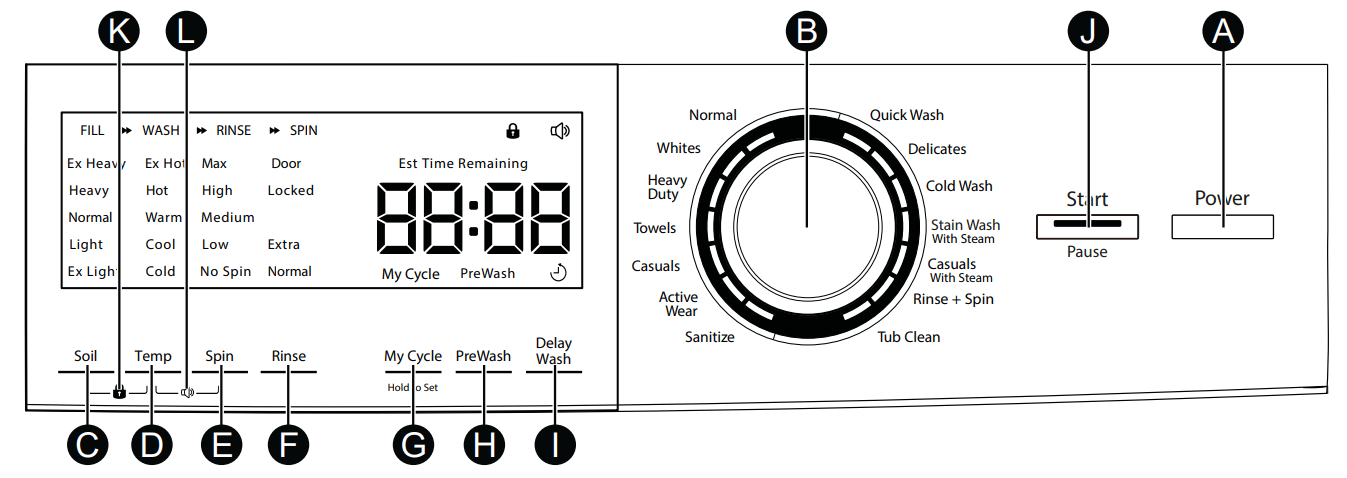
A. Power
Press to “wake up” the display. If the display is active, press to put the washer into standby mode.
NOTE: Pressing Power does not disconnect the appliance from the power supply
B. Wash Cycles
The wash cycles are optimized for specific types of wash loads. The chart below will help you match the wash setting with the loads. The Gentle Wash™ lifters lightly tumble the clothes into the water and detergent solution to clean the load.
C. Soil
 | Changing the Soil level increases or decreases the wash time to remove different amounts of soil. To change the Soil level, press the Soil level button until you have reached the desired setting. You can choose between Extra Light, Light, Normal, Heavy or Extra Heavy soil |
D. Temp
 | Adjust to select the proper water temperature for the wash cycle. The rinse water is always cold to help reduce energy usage and reduce setting of stains and wrinkles. Follow the fabric manufacturer’s care label when selecting the wash temperature. To change the wash temperature, press the Temp button until you have reached the desired setting. You can choose between Cold, Cool, Warm, Hot or Extra Hot. |
E. Spin
 | Changing the Spin setting changes the final spin speed of the cycles. Always follow the garment manufacturer’s care label when changing the Spin setting. To change the Spin setting, press the Spin setting button until you have reached the desired setting. You can choose between No Spin, Low, Medium, High or Max. Higher spin speeds are not available on certain cycles, such as Delicates. Higher spin speeds remove more water from the clothes and will help reduce dry time, but may also increase the possibility of setting wrinkles on some fabrics. |
F. Rinse
 | Changing Rinse will change the number of rinses the cycle will use. To change the rinse option, press Rinse until you have reached the desired setting. You can choose between Normal, Extra and no rinse. In order to select no rinse, press the Rinse button until no lights are lit in the rinse window. On Rinse+Spin cycle, a drain and spin cycle can be achieved by selecting no rinse. |
G. My Cycle
 | To save a favorite cycle, set the desired settings for wash cycle, soil level, spin speed and wash temp settings and hold down the My Cycle button for 3 seconds. A beep will sound to indicate the cycle has been saved. To use your custom cycle, press the My Cycle button before washing a load. To change the saved cycle, set the desired settings and hold down the My Cycle button for 3 seconds. NOTE: When using My Cycle, wash options cannot be modified after the cycle has been started. NOTE: If you change wash options with My Cycle before starting the cycle, the My Cycle light will turn off and you will be returned to the base cycle. |
H. PreWash
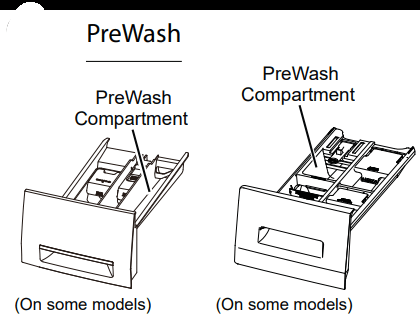 | Prewash is an extra wash before the main wash. Use it for heavily soiled clothes or for clothes with a care label that recommends prewashing before washing. Be sure to add liquid or powder highefficiency detergent, or the proper wash additive to the prewash dispenser. The PreWash feature will fill the washer with water (adding the prewash detergent), tumble the clothes, drain and spin. Then the washer will run the selected wash cycle. NOTE: The PreWash is not selected automatically and must be selected before starting the cycle. |
I. Delay Wash
 | Use to delay the start of your washer.
The countdown time will be shown in the Est Time Remaining (Estimated Time Remaining) display |
J. Start/Pause
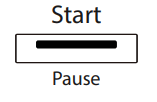 | Press to start a wash cycle. If the washer is running, pressing it once will pause the washer and unlock the door. This function can be used to add garments during a cycle. Press again to restart the wash cycle. NOTE: If the washer is paused and the cycle is not restarted within 15 minutes, the current wash cycle will be cancelled. NOTE: In some cases the washer will drain first, then unlock the door when it is paused. NOTE: The washer performs automatic system checks after pressing the Start/Pause button. Water will flow in 45 seconds or less. You may hear the door lock and unlock before water flows; this is normal. |
K. Lock
 | You can lock the controls to prevent any selections from being made. Or you can lock or unlock the controls after you have started a cycle. Children cannot accidentally start the washer by touching pads with this option selected. To lock the washer, press and hold the Soil and Temp buttons together for 3 seconds. To unlock the washer controls, press and hold the Soil and Temp buttons together for 3 seconds. A sound is made to indicate the lock/unlock status. The control lock icon on the display will light up when it is on. NOTE: The Power button can still be used when the machine is locked. |
L. Signal
 | When the light is on, the washer will beep at the end of the cycle and every time you press a button on the control panel. To turn the signal off, press and hold the Temp and Spin buttons together for 3 seconds. A sound is made to indicate the lock/unlock status. |
CARE AND CLEANING
Water Supply Hoses
Hoses connecting washer to faucet should be replaced every 5 years.
Exterior
Immediately wipe off any spills. Wipe with damp cloth. Wipe or dust spills or washing compounds with a damp cloth. Washer control panel and finishes may be damaged by some laundry pretreatment and stain remover products. Apply these products away from the washer. The fabric may then be washed and dried normally. Damage to your washer caused by these products is not covered by your warranty. Do not hit surface with sharp objects.
Interior
Dry around the washer door opening, flexible gasket (including attached hoses) and door glass. These areas should always be clean to ensure a watertight seal.
It is recommended to rinse the washer at least once per month with 1 cup of bleach (or other commercially available product manufactured for this purpose, such as Tide® Washing Machine Cleaner) poured directly into the basket without clothes and using the Tub Clean Cycle.
Pump Filter
Clean EVERY MONTH to remove any items that may have been caught in the filter or housing.
Due to the nature of the front-load washer, it is sometimes possible for small articles to pass to the pump. The washer has a filter to capture lost items so they are not dumped to the drain. To retrieve lost items, clean out the pump filter.
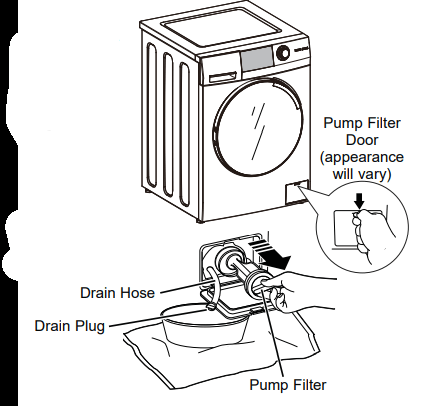
- Open the door on the bottom right of the front of the unit.
- Twist the small white cap counterclockwise a quarter turn and unhook the small rubber hose. Pull the hose out of the hole and remove the white drain hose plug above a small pan to capture any water that may drain. Drain the excess water. Replace.
- Unscrew the pump filter. Rinse off any debris. Replace.
- Close the access door.
Door Gasket
Open the washer door. Using both hands, press down the door gasket. Remove any foreign objects if found trapped inside the gasket. Make sure there is nothing blocking the holes behind the gasket. While holding down the door gasket, inspect the interior of the gasket by pulling it down with your fingers. Remove any foreign objects if found trapped inside this gasket. Make sure there is nothing blocking the holes behind the gasket. When you are finished cleaning the door gasket, remove your hands and the gaskets will return to the operating position. | 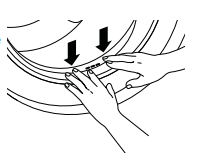 |
Dispenser Drawer Area
Detergent and fabric softener may build up in the dispenser drawer. Residue should be removed once or twice a month.
| • Remove the drawer by first pulling it out until it stops. Then reach back into the rear center of the drawer cavity and press down firmly on the lock tab, pulling out the drawer. | 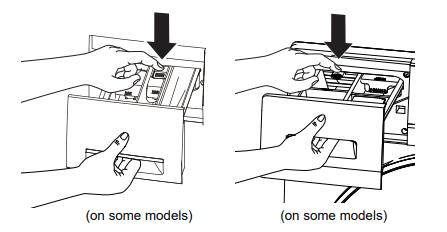 |
| • Remove all cups and inserts from the dispenser drawer. Rinse the inserts, cups and drawer with hot water to remove traces of accumulated laundry products. |  |
• To clean the drawer opening, use a small brush to clean the recess. Remove all residue from the upper and lower parts of the recess. • Return inserts to the proper compartments. Replace the dispenser drawer. • To reduce buildup in the Dispenser Drawer area:  | 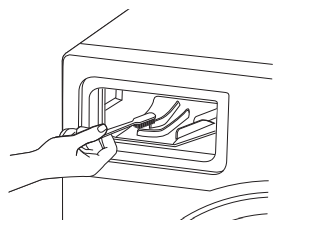 |
Moving and Storage
Ask the service technician to remove water from drain pump and hoses. Do not store the washer where it will be exposed to the weather. When moving the washer, the tub should be kept stationary by using the shipping bolts removed during installation. See Installation Instructions in this manual. If these parts are not available, they can be ordered by visiting our Website at GEApplianceparts.com or by calling GE Appliances at 877.959.8688. In Canada, visit your local GE Appliances parts distributor or call 800.661.1616 or GEAppliances website
Long Vacations
Be sure water supply is shut off at faucets. Drain all water from hoses and water filter pump area if weather will be below freezing
TROUBLESHOOTING TIPS
Problem | Possible Cause | What To Do |
Not draining Not spinning Not tumbling | Load is out of balance | Redistribute clothes and run Rinse+Spin. Increase load size if washing small load containing heavy and light items. |
Pump filter may be clogged | See the Care and Cleaning section on how to clean the Pump Filter. | |
Drain hose is kinked or improperly connected | Straighten drain hose and make sure washer is not sitting on it. | |
Household drain may be clogged | Check household plumbing. You may need to call a plumber. | |
Drain hose siphoning; drain hose pushed too far down the drain | Ensure there is an air gap between hose and drain. | |
Leaking water | Door gasket is damaged | Check to see if gasket is seated and not torn. Objects left in pockets may cause damage to the washer (nails, screws, pens, pencils) Water may drip from the door when the door is opened. This is a normal operation. Carefully wipe off rubber door seal. Sometimes dirt or clothing is left in this seal and can cause a small leak |
Check back left of washer for water | If this area is wet, you have oversudsing condition. Use less detergent. | |
Fill hoses or drain hose is improperly connected | Make sure hose connections are tight at washer and faucets and make sure end of drain hose is correctly inserted in and secured to drain facility. | |
Household drain may be clogged | Check household plumbing. You may need to call a plumber. | |
Dispenser clogged | Powder soap may cause clogs inside the dispenser and cause water to leak out the front of the dispenser. Remove drawer and clean both drawer and inside of dispenser box. Please refer to Care and Cleaning section. | |
Incorrect use of detergent | Use only HE and correct amount of detergent. | |
Clothes too wet | Load is out of balance | Redistribute clothes and run Rinse+Spin. |
Increase load size if washing small load containing heavy and light items. | ||
Pump filter may be clogged | See the Care and Cleaning section on how to clean the Pump Filter. | |
Overloading | Load your washer so clothes have enough room to move freely. | |
Drain hose is kinked or improperly connected | Straighten drain hose and make sure washer is not sitting on it. | |
Household drain may be clogged | Check household plumbing. You may need to call a plumber. | |
Drain hose siphoning; drain hose pushed too far down the drain | Ensure there is an air gap between hose and drain. |
Incomplete cycle or timer not advancing | Automatic load redistribution | Timer stops at 1 minute; machine has redistributed the load once or twice. This is normal operation. Do nothing; the machine will finish the wash cycle. |
Pump filter may be clogged | See the Care and Cleaning section on how to clean the Pump Filter. | |
Drain hose is kinked or improperly connected | Straighten drain hose and make sure washer is not sitting on it. | |
Household drain may be clogged | Check household plumbing. You may need to call a plumber. | |
Drain hose siphoning; drain hose pushed too far down the drain | Ensure there is an air gap between hose and drain. | |
Loud or unusual noise; vibration or shaking | Cabinet moving | Washer is designed to move 1/4” to reduce forces transmitted to the floor. This movement is normal. |
All rubber leveling legs are not firmly touching the floor | Push and pull on the back right and then back left of your washer to check if it is level. If the washer is uneven, adjust the rubber leveling legs so they are all firmly touching the floor and locked in place. | |
Unbalanced load | Pause unit, open door and manually redistribute load. To check machine, run rinse and spin with no load. If normal, unbalance was caused by load. | |
Pump filter may be clogged | See the Care and Cleaning section on how to clean the Pump Filter. | |
No power/washer not working or dead | Washer is unplugged | Make sure cord is plugged securely into a working outlet. |
Water supply is turned off | Turn both hot and cold faucets fully on. | |
Circuit breaker/fuse is tripped/blown | Check house circuit breakers/fuses. Replace fuses or reset breaker. Washer should have separate outlet. | |
Automatic self system checks | First time the washer is plugged in, automatic checks occur. It may take up to 20 seconds before you can use your washer. This is normal operation. | |
Snags, holes, tears, rips or excessive wear | Pens, pencils, nails, screws or other objects left in pockets | Remove loose items from pockets. |
Pins, snaps, hooks, sharp buttons, belt buckles, zippers and sharp objects left in pockets | Fasten snaps, hooks, buttons and zippers. | |
Control time wrong or changes | This is normal | During spin the washer may need to rebalance the load sometimes to reduce vibrations. When this happens, the estimated time is increased causing time left to increase or jump. |
Not enough water | This is normal | Horizontal washers do not require the tub to fill with water like top-load washers. |
Washer pauses or has to be restarted, or washer door is locked and will not open | Pump filter may be clogged | See the Care and Cleaning section on how to clean the Pump Filter. |
Door unlocks or press Start and machine doesn’t operate | This is normal | Front-load washers start up differently than top-load washers, and it takes several seconds to check the system. The door will lock and unlock. |
Incorrect operation | Simply open and close the door firmly; then press Start. |
Water does not enter washer or enters slowly | Automatic self system checks | After Start is pressed, the washer does several system checks. Water will flow several seconds after Start is pressed. |
Water valve screens are stopped up | Turn off the water source and remove the water connection hoses from the upper back of the washer. Use a brush or toothpick to clean the screens in the machine. Reconnect the hoses and turn the water back on. | |
Inlet hose screen washers are stopped up | Turn off the water source and remove the inlet hoses from the wall faucets. Use a brush or toothpick to clean the screen washers in the end of the hoses. Reconnect the hoses and turn the water back on. | |
Pump filter may be clogged | See the Care and Cleaning section on how to clean the Pump Filter. | |
Fill hoses may be kinked | Check that fill hoses are not kinked or clogged. | |
Water supply is turned off | Turn on both hot and cold faucets fully. | |
Energy efficiency | This is an energy-efficient washer. As a result, the temperature settings for this washer may be different than for a non-energy-efficient washer. | |
Insufficient water supply | Make sure that the water supply is turned on. Make sure that the water faucets are turned to their completely open position. | |
The washer door is open | The washer door must be closed for all washer cycle operations. If the door is opened during the washer operation, all functions will stop, including water filling. | |
Incorrect fill hose connection | Make sure that the fill hoses connect the hot water supply to the hot inlet on the washer and the cold water supply to the cold inlet on the washer (hot to hot, cold to cold). | |
Wrinkling | Improper sorting | Avoid mixing heavy items (like work clothes) with light items (like blouses). |
Overloading | Load your washer so clothes have enough room to move freely. | |
Incorrect wash cycle | Match cycle selection to the type of fabric you arewashing (especially for easy care loads). | |
Repeated washing in water that is too hot | Wash in warm or cold water. | |
Grayed or yellowed clothes | Not enough detergent | Use correct amount of detergent. |
Not using HE (high efficiency) detergent | Use only HE detergent. | |
Hard water | Use hottest water safe for fabric. | |
Use a water conditioner like Calgon brand or install a water softener. | ||
Water is not hot enough | Make sure water heater is delivering water at 120°-140°F (48°-60°C). | |
Detergent is not dissolving | Try a liquid HE detergent. | |
Dye transfer | Sort clothes by color. If fabric label states wash separately, unstable dyes may be indicated. |
Colored spots | Incorrect use of fabric softener | Check fabric softener package for instructions and follow directions for using dispenser. |
Dye transfer | Sort whites or lightly colored items from dark colors. | |
Promptly remove wash load from washer. | ||
Water temperature is incorrect | Water supply is improperly connected | Make sure hoses are connected to correct faucets. |
House water heater is not set properly | Make sure house water heater is delivering water at 120°-140°F (48°-60°C). | |
Slight variation in metallic color | This is normal | Due to the metallic properties of paint used for this unique product, slight variations of color may occur due to viewing angles and lighting conditions. |
Bad odor inside your Washer | Washer unused for a long time, not using recommended quality of HE detergent or used too much detergent | Run a Tub Clean cycle. |
In case of strong odor, you may need to run the Tub Clean cycle more than once. | ||
Use only the amount of detergent recommended on the detergent container. | ||
Use only HE (high efficiency) detergent. | ||
Always remove wet items from the washer promptly after machine stops running. | ||
Leave the door slightly open for the water to air dry. Close supervision is necessary if this appliance is used by or near children. Do not allow children to play on or in this or any other appliance. | ||
Detergent leak | Incorrect placement of detergent insert | Make sure detergent insert is properly located and fully seated. Never put detergent above max line. |
This is normal | It is normal operation to see detergent leak on door gasket about 20 seconds after filling the dispenser. | |
Improper dispensing of softener | Dispenser clogged | Monthly clean the dispenser drawer to remove buildup of chemicals. |
Softener is filled above the max line | Make sure to have the correct amount of softener. | |
Softener cap issue | Make sure softener cap for dispenser is seated or it will not work. | |
Dispenser drawer not dispensing properly | Laundry detergent packet placed in dispenser drawer | Laundry detergent packets should not be used in the dispenser. They should only be added directly to the wash tub following the manufacturer's directions. |
Pump running while washer is not in use | Clog in sump drain | This is normal. Drain sump is detecting an undesired water fill level from a potential open faucet. Shut off water valve and inspect water valve for blockage. |
See other models: DPSE810EGWT GDT696SSF1SS PVM9179DK3WW PVM9179DF1WW PVM9179DF2BB
 in your energy efficient washer. Place detergent pods in the bottom of the wash basket before adding clothes.
in your energy efficient washer. Place detergent pods in the bottom of the wash basket before adding clothes.